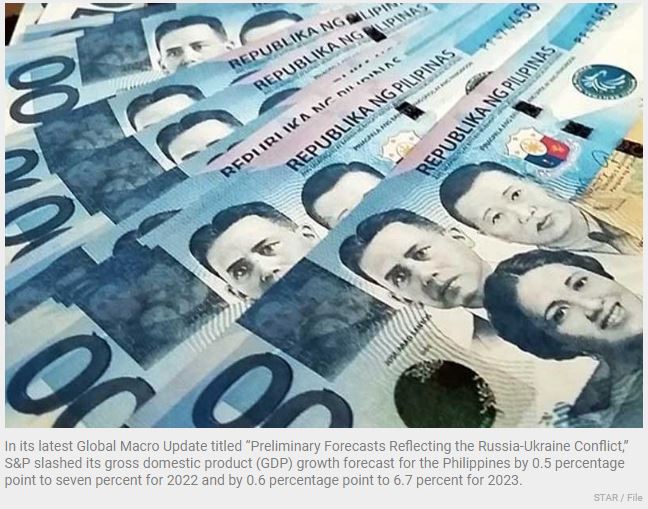Debt watchers expect slower growth, high inflation for Philippines
MANILA, Philippines — The Philippines is expected to post slower economic growth and higher inflation this year despite an assurance from the Bangko Sentral ng Pilipinas (BSP) that the country is insulated from the ongoing Russia-Ukraine war, according to S&P Global Ratings and Moody’s Investors Service.
In its latest Global Macro Update titled “Preliminary Forecasts Reflecting the Russia-Ukraine Conflict,” S&P slashed its gross domestic product (GDP) growth forecast for the Philippines by 0.5 percentage point to seven percent for 2022 and by 0.6 percentage point to 6.7 percent for 2023.
This is the lower end of the seven to nine percent GDP growth target penned by economic managers through the Cabinet-level Development Budget Coordination Committee (DBCC) for this year.
Despite the cut, the Philippines still emerges as the fastest growing economy in Southeast Asia as well as the second fastest in Asia this year and the fastest in 2023.
The Philippines’ GDP growth for this year is lower than India’s 7.8 percent, but faster than Malaysia’s 5.8 percent, Indonesia’s 5.2 percent, China’s 4.8 percent, Australia’s and Singapore’s 3.6 percent, Japan’s 2.6 percent, Taiwan’s and Korea’s 2.3 percent and Hong Kong’s 2.2 percent.
For 2022, the GDP expansion of the Philippines is faster than India’s six percent, Malaysia’s 5.3 percent, China’s five percent, Indonesia’s 4.6 percent, Taiwan’s three percent, Singapore’s 2.9 percent, South Korea’s 2.7 percent, Australia’s 2.6 percent and Japan’s 1.4 percent.
For 2023, S&P still expects the Philippines to be the fastest growing economy in Asia after its GDP growth forecast was upgraded by 0.4 percent to 7.6 percent.
S&P also raised the inflation forecasts for the Philippines by 0.9 percentage point to 3.3 percent for this year, still within the two to four percent target set by the BSP.
The debt watcher now expects the US Federal Reserve to start normalizing monetary policy sooner and faster than originally expected, leading to higher and more persistent inflation, with a larger demand-driven component requiring a policy response.
S&P now expects six rate increases of 25 basis points each by the US Fed this year followed by five more hikes in 2023 and 2024.
It also assumed a policy reaction for China to offset growth effects of the Russia-Ukraine conflict designed to keep forecast growth rate this year.
As a result, S&P sees global growth declining by 70 basis points to 3.4 percent this year due largely to the recession in Russia, while it expects most of Asia- Pacific and emerging markets outside Europe to show only modest changes in growth and inflation.
On the other hand, Moody’s sees inflationary pressures building faster in the Philippines as it is a net importer of oil.
“Inflationary pressures are likely to build faster in economies where fuel and electricity prices have a heavier weighting in consumption baskets, or where imported fuel is predominant: these include India, Laos, Pakistan, Philippines, Sri Lanka and Vietnam,” Moody’s said.
Moody’s added that the pressure on governments to raise subsidies would increase, leading to greater fiscal strains.
“Russia’s invasion of Ukraine carries growing risks to Asia Pacific,” it said.
The debt watcher identified the channels of transmission of geopolitical risk to global credit risk as commodity price and supply interruptions fueling inflation; financial, economic and business disruption; and security challenges, including cyber risk.
“Despite relatively small direct economic and financial linkages to Russia and Ukraine, many economies in Asia-Pacific will face heightened macroeconomic risks from the shock to global commodity prices and constrained access to industrial metals. Several economies risk backsliding on debt consolidation and an exacerbation of pandemic-driven scarring,” Moody’s said.
Source: https://www.philstar.com/business/2022/03/18/2168014/debt-watchers-expect-slower-growth-high-inflation-philippines


 Thailand
Thailand




